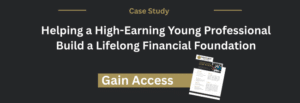Retirement isn’t a finish line—it’s a transition into a new lifestyle. For high-net-worth individuals, planning for that shift requires more than savings and investment returns. It’s about creating a plan that supports your lifestyle, minimizes taxes, protects your estate, and allows you to give back or pass on your legacy. Whether you’re looking to preserve your wealth or put it to work, this guide offers a complete roadmap to retirement planning with clarity, control, and confidence.
What Counts as “High Net-Worth”?
A high-net-worth individual typically has $1 million or more in liquid assets, excluding their primary residence. They often have multiple income streams—such as business interests, rental properties, or investment portfolios—and face complex financial needs, including tax planning, trust and estate design, and risk management. This guide is handy for those with $800,000 to $5 million or more in investable assets who are seeking a long-term strategy tailored to their financial goals and lifestyle.
7 Key Components of Retirement Planning for HNWIs
1. Define Your Vision for Retirement

Instead of asking, “When can I retire?” ask:
- What does an ideal retirement look like for me?
- What lifestyle do I want to maintain?
- Will I continue working part-time, traveling, starting a business, or giving back?
Once you have this picture, your financial plan becomes more than numbers—it becomes purpose-driven.
2. Structure a Diversified, Tax-Efficient Investment Portfolio
Wealthy retirees need growth, income, and protection—all at once. A few strategic steps:
- Maximize retirement accounts (401(k), IRA, HSA)
- Consider Roth conversions when your tax bracket drops
- Split assets wisely: put tax-inefficient assets (like bonds or REITs) in tax-advantaged accounts
- Explore alternatives: private equity, real estate, hedge funds—if they align with your goals
3. Plan for Multiple Income Streams

Don’t rely on just one source. Retirement income for HNWIs often includes:
- Dividends and capital gains from investments
- Social Security (claiming at the right time can increase your benefits)
- Income from real estate or business assets
- Tax-advantaged withdrawals from IRAs or 401(k)s
- Deferred compensation plans, annuities, or pensions
The key is to strategically sequence withdrawals to reduce taxes and extend your portfolio.
4. Build a Long-Term Tax Strategy
High income and capital gains can trigger major tax burdens. A strong plan includes:
- Asset location: placing investments in the right accounts for tax efficiency
- Tax-loss harvesting: to offset gains
- Charitable giving: using donor-advised funds or qualified charitable distributions
- Strategic gifting: reduce estate size by giving to heirs annually within IRS limits
- Trusts: for income planning and generational wealth transfer
Partner with a financial advisor and tax professional to stay ahead of policy changes.
5. Protect Your Wealth and Lifestyle
You’ve worked hard to build your wealth—now you need to shield it.
Consider:
- Umbrella insurance: for lawsuits or liabilities
- Long-term care insurance: especially if family health history is a concern
- Life insurance: for liquidity or estate tax protection
- Asset protection trusts: to insulate wealth from legal risk
Also, stress-test your portfolio to simulate recessions, inflation, or medical emergencies.

6. Design Your Legacy and Estate Plan
Legacy is more than passing down money—it’s about passing down purpose.
Use tools like:
- Revocable living trusts: to avoid probate and provide privacy
- Irrevocable trusts: for asset protection and tax planning
- Family limited partnerships: to transfer business or real estate assets strategically
- Charitable trusts or foundations: to align giving with your values
- Letter of intent: to guide heirs on how you’d like assets used
Keep documents updated and educate your beneficiaries.
7. Regularly Revisit and Adjust Your Plan

The market changes. Tax laws evolve. Family dynamics shift.
Your retirement plan should never be “set and forget.”
Review your strategy:
- Annually with your advisor
- After major life events (e.g., divorce, business sale, inheritance)
- When tax laws or investment environments shift
Common Pitfalls HNWIs Should Avoid
Even seasoned investors can miss key areas:
- Neglecting estate planning or delaying critical decisions
- Underestimating longevity or long-term care needs
- Overexposing portfolios to market risk or holding too much in one asset class
- Overlooking insurance gaps
- Failing to educate heirs about handling inherited wealth
Why Work With a Fee-Only Financial Advisor?
Fee-only advisors (like Winthrop Partners) work for you—not commissions. This matters when:
- You need objective investment advice
- Your tax picture is complex
- You want to minimize conflicts of interest
- You’re planning for multi-generational wealth
We offer fiduciary-level retirement planning that puts your needs—and your family’s future—first.
A well-crafted retirement plan does more than grow wealth—it provides freedom, peace of mind, and purpose. For high net-worth individuals, retirement is a chapter where financial complexity and personal values intersect.
Ready to map your retirement with clarity and confidence?
[Book a personalized consultation with Winthrop Partners today.]

Thomas Saunders is the Managing Partner of Winthrop Partners. Prior to founding Winthrop Partners, Tom was Senior Vice President at what is now JP Morgan. His career includes senior and executive roles at Brown Brothers Harriman and First Niagara Bank, a top 25 Bank. Click here to contact Thomas Saunders about your investment and planning requirements.

